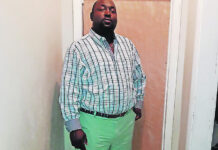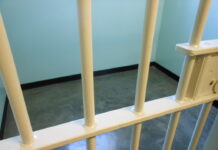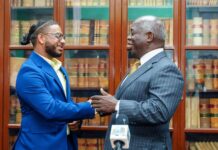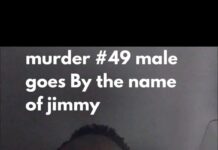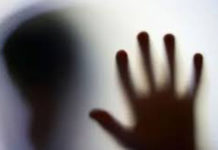James S. Brady not only saved the President, but many more lives in his fight on Gun Control…
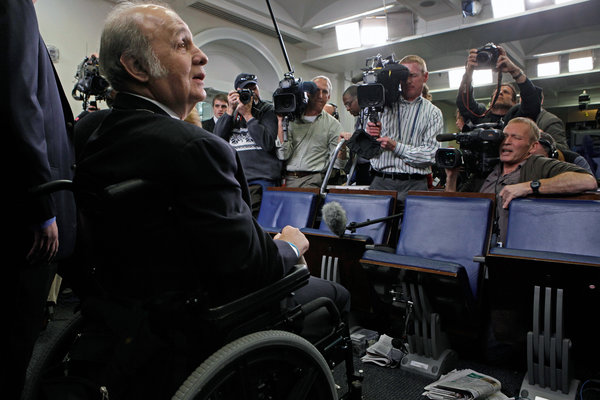
By JAMES BARRON
AUG. 4, 2014
The New York Times
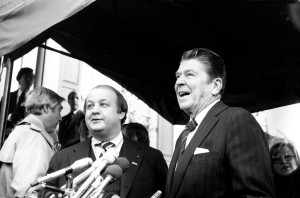
James S. Brady, the White House press secretary who was wounded in an assassination attempt on President Ronald Reagan and then became a symbol of the fight for gun control, championing tighter regulations from his wheelchair, died on Monday in Alexandria, Va. He was 73.
His family confirmed the death but did not specify a cause.
On the rainy afternoon of March 30, 1981, Mr. Brady was struck in a hail of bullets fired by John W. Hinckley Jr., a mentally troubled college dropout who had hoped that shooting the president would impress the actress Jodie Foster, on whom he had a fixation. Mr. Hinckley raised his handgun as Reagan stepped out of a hotel in Washington after giving a speech.
Reagan, a couple of paces from his limousine, was hit, as were a Secret Service agent and a District of Columbia police officer. But it was Mr. Brady, shot in the head, who was the most seriously injured. The bullet damaged the right section of his brain, paralyzing his left arm, weakening his left leg, damaging his short-term memory and impairing his speech. Just getting out of a car became a study in determination.
“What I was, I am not now,” Mr. Brady said in 1994. “What I was, I will never be again.”
What Mr. Brady became was an advocate of tough restrictions on the sale of handguns like the $29 pawnshop special that Mr. Hinckley had bought with false identification. “I wouldn’t be here in this damn wheelchair if we had common-sense legislation,” Mr. Brady said in 2011.
Mr. Brady and his wife, Sarah, campaigned for a bill that Congress passed 12 years after the shooting. The Brady Handgun Violence Prevention Act, as it was known, ushered in background checks and waiting periods for many gun buyers.
The Bradys also pressed for the restoration of a federal ban on assault weapons, which expired in 2004.
They issued statements calling for renewed restrictions after episodes like the school shooting in Newtown, Conn., in 2012. Last year, after Gov. Andrew M. Cuomo of New York pushed a gun-control bill through the state legislature, the Bradys appeared in a commercial thanking Mr. Cuomo for, as Mrs. Brady put it, “leading the way.” Mrs. Brady said they had been asked to record the commercial by Mr. Cuomo’s sister Maria Cuomo Cole, a friend of hers.
Mr. Brady returned to the White House occasionally. He spoke briefly with President Obama — whom he had endorsed in 2008 — in 2011 on the 30th anniversary of the assassination attempt. Mr. Brady wore a blue bracelet with Representative Gabrielle Giffords’s name on it and told reporters that he had shown it to the president. Ms. Giffords had been wounded a few weeks earlier in a shooting in Tucson that left six people dead and 12 others injured.
Mrs. Brady said that the president agreed with “everything that we are for,” but that he told them the process in Washington took time. She said Mr. Brady told the president, “It takes two years to make Minute Rice.”
The Bradys later sent recommendations to a White House task force on preventing gun violence, calling for universal background checks. They also recommended safety programs for the nation’s gun owners; Americans own almost 300 million firearms.
After 32 people were killed in shootings at Virginia Tech in 2007, the Bradys supported a bill that closed a loophole that had allowed the gunman to buy weapons even though he had earlier been committed to a mental hospital. President George W. Bush signed the measure into law in January 2008.
In the 1990s, when he was pressing for the Brady bill, Mr. Brady dismissed as “lamebrain nonsense” the National Rifle Association’s contention that a waiting period would inconvenience law-abiding people who had reason to buy a gun. The idea behind the waiting period was to give the seller time to check on whether the prospective purchaser had a criminal record or had lied in supplying information on the required documents.
Mr. Brady said that five business days was not too much to make purchasers wait. Every day, he once testified, “I need help getting out of bed, help taking a shower and help getting dressed, and — damn it — I need help going to the bathroom. I guess I’m paying for their ‘convenience.’ “
As the Bradys worked the phones, shoring up supporters, opposition to the bill softened in Congress in the wake of a surge in gun-related violence across the nation and public opinion polls showing crime and violence to be top priorities for Americans. On Nov. 30, 1993, President Bill Clinton signed the Brady bill into law, with Mr. Brady at his side in a wheelchair.
Still, the Brady bill made it to the White House only after an intensive series of negotiations in the Senate. Eventually, Republicans agreed to a vote in exchange for Democratic assurances of future modifications.
“How sweet it is; how long it took,” Mr. Brady said on the way to the signing ceremony. The Brady Center estimated that the restrictions in the Brady bill have blocked two million gun purchases.
Advocating gun restrictions was not the role Mr. Brady had envisioned for himself when he became the White House press secretary in 1981. He was clearly proud of having what he called, with equal parts seriousness and humor, “the second most challenging job in the free world.”
He had a reputation as a Washington insider. He was also known for his wisecracks, though they sometimes boomeranged on him. As Reagan’s director of public affairs and research during the 1980 presidential race, he was banned from the campaign plane for a week. The offense: He and another Reagan aide had shouted “killer trees, killer trees!” while flying over a forest fire. The remark was a not terribly subtle reminder that Reagan had once identified trees as a major source of air pollution.
On his 84th day at the White House, he followed Reagan to a midday speech at the Washington Hilton. As they stepped out into the rain afterward, Mr. Hinckley raised his .22-caliber revolver and fired six shots in less than two seconds, hitting the president in the chest and lower right arm and Mr. Brady above one eye. Two Secret Service agents and a police officer were also injured.
They were taken to George Washington University Hospital, where one team of doctors operated on Reagan while another operated on Mr. Brady. He remained hospitalized for nine months, and after he was discharged he returned for physical therapy every day. He could manage only a few steps at a time, and sometimes he would blank out. A year or so later, when he started trying to write his name, it would come out JIMMMMMMMMMMMMMMMMM.
As for the gunman, “maybe he’ll be on the streets someday,” Mr. Brady said in the authorized 1987 biography “Thumbs Up,” by Mollie Dickinson. “I can’t remember things, I’m here in the hospital every day. Wouldn’t you be depressed?”
Mr. Hinckley was found not guilty by reason of insanity in 1982 and has been confined to a Washington mental hospital since, although he has been allowed to travel to his family’s home in Williamsburg, Va.
Mr. Brady filed a civil suit against Mr. Hinckley, and 14 years after the shooting, Mr. Hinckley agreed to give Mr. Brady and two other victims the profits made from selling his life story. Mr. Brady and the others — Thomas K. Delahanty, a former District of Columbia police officer, and Timothy J. McCarthy, a former Secret Service agent — stood to divide up to $2.9 million selling book and movie rights about Mr. Hinckley.
In a statement released on Monday, Nancy Reagan, the former first lady, recalled the hours after the assassination attempt when she and Mrs. Brady “sat together in a tiny room near the emergency room at George Washington University Hospital, trying to comfort each other while we both were gripped with unspeakable fear.”
“The bond we established then was unlike any other,” she added.
Thinking of Mr. Brady, Mrs. Reagan said, “brings back so many memories — happy and sad — of a time in all of our lives when we learned what it means to ‘play the hand we’re dealt.’ ” James Scott Brady was born on Aug. 29, 1940, in Centralia, Ill., the only child of Dorothy and Harold Brady, a railroad yardmaster. James Brady grew up to be a train enthusiast with fond memories of the times he had sat in the engineer’s lap and run a switching locomotive.
Before graduating from the University of Illinois in 1962, he served as the president of the campus Young Republicans and the district governor of the state Young Republicans organization. He entered the University of Illinois law school that fall, and in 1963, he was chosen for a summer internship at the Justice Department in Washington. To cover his expenses, he also sold encyclopedias door to door and collected empty soft-drink bottles, redeeming them for the small change he got from the deposits.
Eventually, he quit law school, tried accounting (but gave it up) and earned a doctorate in public administration at Southern Illinois University. He returned to Washington, where he worked for three federal agencies, the House of Representatives (as a communications consultant) and Senators Everett M. Dirksen of Illinois and William V. Roth Jr. of Delaware before he signed on with Reagan.
After the shooting, he also served as the chairman of the National Organization on Disability, a nonprofit group that advocates better conditions for handicapped people, and as a spokesman for the National Head Injuries Foundation.
Besides his wife, Mr. Brady’s survivors include a son, James Scott Brady Jr., and a daughter, Melissa Jane, from his first marriage, which ended in divorce. Mr. Brady lived in Alexandria.
Mr. Clinton awarded him the Presidential Medal of Freedom, the country’s highest civilian honor, in 1996, and in 2000, Mr. Clinton presided at the renaming of the room in which White House news briefings are held. It became the James S. Brady Press Briefing Room.
Later, one of the organizations with which the Bradys were associated changed its name from Handgun Control Incorporated to the Brady Campaign to Prevent Gun Violence. Another, the Center to Prevent Handgun Violence, became the Brady Center to Prevent Gun Violence. Mr. Brady was an honorary trustee of both groups.
Mr. Brady — who said he did not remember much about the day he was shot — said over the years that he had remained concerned that guns were still available to people with mental problems like Mr. Hinckley.
“He scares me,” Mr. Brady told CBS News in 2006, “because he doesn’t have 52 cards in his deck. He didn’t the day that he shot at us. He got six rounds off and hit four of us.”
But when Mr. Brady was asked if he was bitter toward Mr. Hinckley, he said, “Well, it’s not classy to be bitter, and I try to be classy.”


